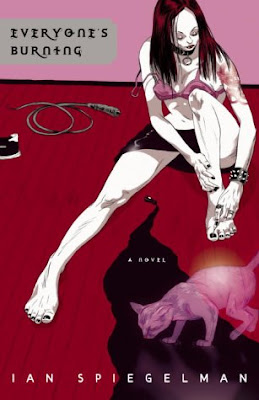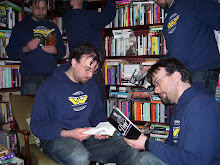* * *
Sigizmund Krzhizhanovsky: Memories of the Future
NYRB, 2009
The seven strange, surreal and fantastic stories collected here were written in the 1920s, but given that Krzhizhanovsky was living in the Soviet Union, and given to a darkly satirical view of life, he wisely kept them hidden. Not published until decades after his death in 1950, they’re now available in English in Joanne Turnbull’s fine translation.
And they are some seriously peculiar and wonderful stories: the Eiffel Tower achieves self-awareness after having radio transmitters installed in its summit, goes on a rampage, and then commits suicide; humanity’s collective subconscious plots a revolution against the waking world; an apartment grows bigger and bigger, though apparently unchanged on the outside, dwarfing the increasingly paranoid occupant.
The highlight is the nearly 100-page title story, in which a man with a unique view of time and human perception tries to build a working time machine, while the forces of Russian history work to frustrate him. And then he succeeds, and visits the Soviet future, which is not represented in a way Stalin would have appreciated.
Martine McDonagh: I Have Waited, and You Have Come
Myriad Editions, 2006
Science fiction is often the characters who turn out to be the most important people in the story’s imagined world: they create the world-shattering invention, or lead the fight against some strange oppressor, or discover the truth behind the warped reality, or encounter the weird other, or are the rare survivors of some cataclysm who must build the world anew. But some science-fiction books (usually the ones frantically marketed as not being SF by their publishers) create a world, but then look at some ordinary lives being lived there (see Ken Kesey’s vastly underrated Sailor Song, or Harry Harrison’s Make Room! Make Room!).
McDonagh’s first novel is set in the middle of this century, in a global-warming-devastated Britain. Her heroine lives alone on the fringes of a small community in the Midlands, with much of the land around her flooded out and depopulated. But it’s not a John Wyndham-style tale of being a survivor, or at least not most significantly. Instead, it’s a story of sexual obsession and broken trust, with the sodden (and wonderfully rendered) landscape a constant, literally atmospheric presence.
Gyula Krúdy: Adventures of Sindbad
Central European University Press, 1998
In the unlikely event that somebody puts a gun to my head and tells me that I can only read the work of writers who flourished under the Austro-Hungarian Empire, I could probably live with that. There are so many who are so great, and they produced an extraordinary collection of brilliant novels and plays and stories and poems, birthed in the massively complex multi-cultural, multi-religious, multi-lingual humanistic pan-European society that was destroyed by the First World War.
One of Hungary’s greatest writers, Krúdy published this novel of short stories in 1911, shortly before everything went to hell, and it was translated into English by George Szirtes in 1998. It’s a strange and beautiful book about an aristocratic Hungarian going by the name of Sindbad, who’s either unmoored in time or else hundreds of years old, pursuing both women and Woman, all rendered in some deeply lush, dreamy prose.
William Hazlitt: Liber Amoris (The Book of Love)
The Hogarth Press, 1985 / Bookkake, 2008
Hazlitt was one of the great essayists of two centuries ago, and his reviews and articles are vivid and powerful today. This odd little book, published pseudonymously in 1823 (and available free here) , was an attempt to record, explain and exorcise a romantic/erotic obsession that almost destroyed him. In the midst of getting divorce, Hazlitt fell disastrously in love with his landlady’s daughter, Sarah Walker, on the basis of a little flirting, and was unable to accept that she wasn’t interested in him.
He collected together his letters to her, and to other friends, some of her notes to him, records of their conversations and arguments, and notes about his own feelings and behaviour. The result is a vivid and compelling portrayal of a ridiculous but unstoppable infatuation, presented with a weird mix of clarity and monomania. It also almost ruined his reputation.
Justin Evans: A Good and Happy Child
Three Rivers, 2008
I first mentioned this back here, as a book I was drawn to because of the cover. I’m glad I was, because it’s excellent: a deeply creepy look at madness, loneliness and demonic possession. A troubled man in a troubled marriage looks back at his unhappy childhood, when he made a special Friend. To say much more risks ruining the plot, but it’s very well done, and wears a lot of esoteric and fascinating research very lightly.
* * *
More to come...























































